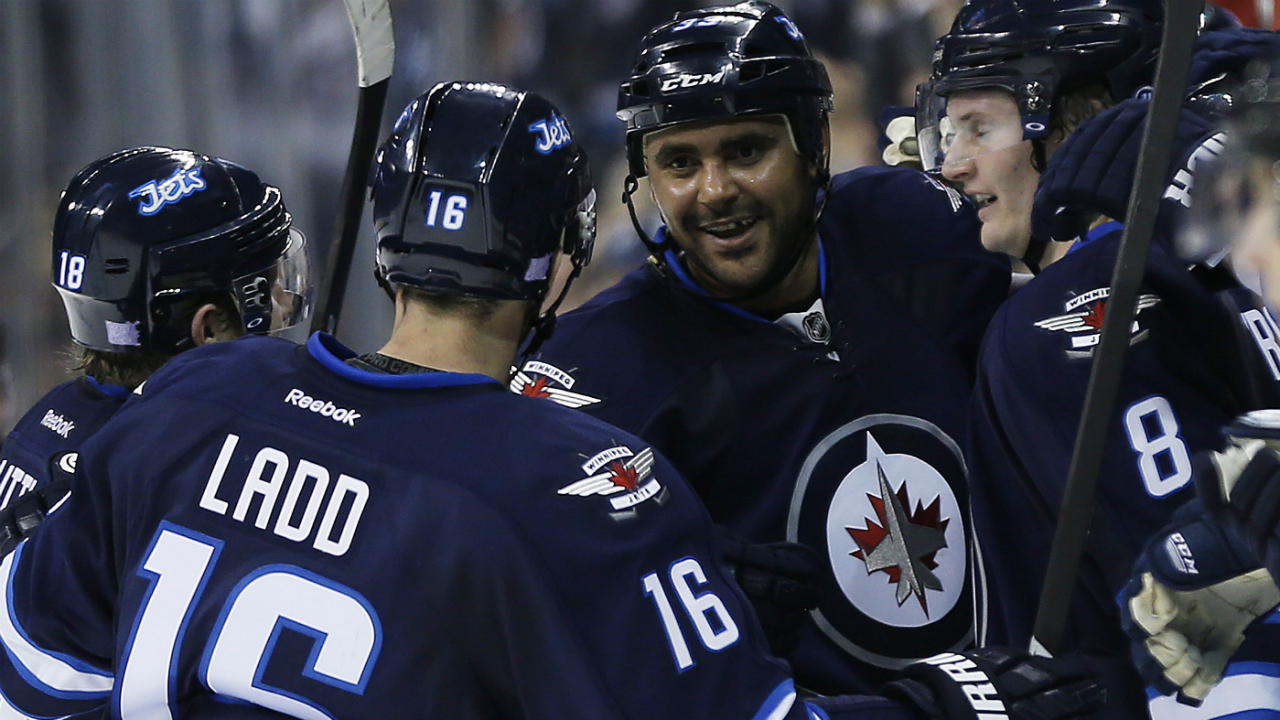Like the man himself, the question of what to do with Dustin Byfuglien carries a few fascinating and—from the perspective of the Winnipeg Jets—potentially taxing dimensions.
We’re used to discussing approach with Byfuglien in the context of which position the swingman should play. But with one year left before Big Buff can fly the Jets’ coop as an unrestricted free agent, the most pressing issue is macro in nature: Should Winnipeg push to sign Byfuglien long-term or is a team with a stocked prospect cupboard better off moving a somewhat-volatile entity and saving some money?
If there’s an easy answer to this one, we haven’t spotted it yet.
The case for trying to keep the 30-year-old (who, for what it’s worth, has thus far made no declaration about his intention to stay in Manitoba) is really clear on some nights. Those would be the ones where Byfuglien unleashes the rocket shot that helps make him among the most offensively threatening blueliners in the league; or when he uses that six-foot-five, 2??-lb. (do we really know?) frame to remind opponents that, sometimes, he’s just flat-out threatening.
Byfuglien in full flight is an aesthetic unmatched by much in hockey, and he has the ability to impact the game in ways precious few do.
Recall, the man scored 11 goals in 22 games primarily as a forward for the Chicago Blackhawks during the team’s 2010 Stanley Cup run. Even assuming he plays defence for Winnipeg, there’s no reason the Jets—in a tight playoff series—couldn’t unleash him up front to terrorize opposing blueliners.
Byfuglien’s go-for-it gene can get the better of him sometimes, but the good outweighs the bad by a fairly hefty margin. Bottom line, he’s a wonderful—though slightly unpredictable—multi-purpose weapon to have.
But that doesn’t make this a slam-dunk call.
Byfuglien is slated for a $5.2-million cap hit in the final year of his expiring five-year contract and you can bet his next ask will reside north of there.
Even accounting for the new deals captain Andrew Ladd (a pending UFA) and youngsters Jacob Trouba and Mark Scheifele (both soon-to-be RFAs) need before the start of 2016-17, Winnipeg is in pretty good shape under the cap. That said, the Jets are a cost-conscious club and internal budgets—not the spending limits imposed by the league—are the driving force behind its economic choices.
That opens the door to a conversation about trading Byfuglien right now, when you’d figure to get quite a hefty return. A move like that, which would negate the possibility of the American leaving for nothing next summer, would be consistent with the way GM Kevin Cheveldayoff has run things during his time in Winnipeg — with one eye always firmly fixed on the future.
All that patient building, though, is starting to come to fruition for the Jets, whose playoff appearance in the Prairie-tough Western Conference last year was no fluke. Winnipeg, no doubt, still has some questions to answer and, given the unforgiving nature of its conference, simply making it back to the post-season would be an accomplishment in itself.
Still, if the goaltending spike the Jets got last year stands up and a few things break right, is there any reason not to view Winnipeg as a team that can do some playoff damage?
Sure, they were swept aside in four first-round games by the Anaheim Ducks last spring, but that’s precisely how things went for the Tampa Bay Lighting in 2014, one year before the team advanced to the Cup final. The circumstances don’t perfectly align, but it’s a comparison worth making given Winnipeg’s trajectory and the increasingly wide-open nature of the Stanley Cup playoffs.
With that in mind, the best plan for Winnipeg might be to sit tight and see how the first quarter of the season plays out. If things are coming together, hang on to Byfuglien and see if he can’t help you win a playoff round or two. How nice would that be for a city that hasn’t seen its team on the right side of a handshake line since 1987? Yes, you run the risk he leaves for nothing, but with 21-year-old Trouba, 25-year-old Tyler Myers and prospect Josh Morrissey in the blueline mix, the Jets are positioned to withstand that worst-case scenario.
On the flipside, if watching 20 games reveals goalies Ondrej Pavelec and Michael Hutchinson aren’t up to the task or sees the return of that nasty injury bug that ripped through the Jets’ defence last year, put Byfuglien on the block and see what you can get. It won’t be as much as you would land right now, but that’s not the end of the world for a team with a sturdy prospect pipeline that’s about to spit out forwards like Nikolaj Ehlers, Nic Petan and the aforementioned Morrissey.
In other words, Winnipeg should do what Byfuglien would: take a little gamble and worry about the next move when you must.








